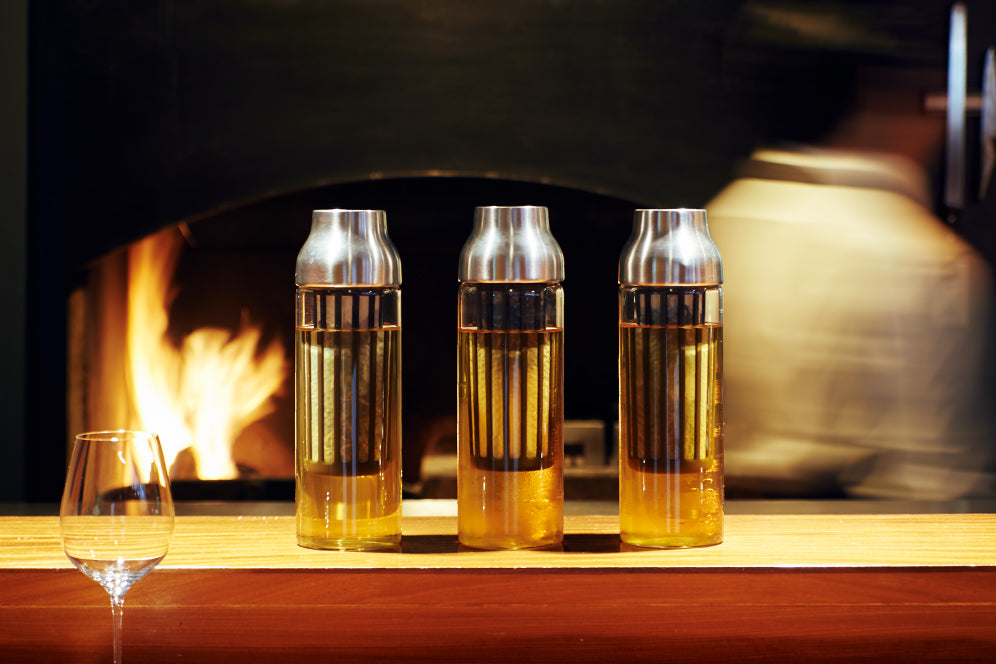
TACUBO is an Italian restaurant which opened in Daikanyama, Tokyo, in 2016. The restaurant celebrates the beauty and vitality of nature—through meat dishes cooked on wood grill, seasonal menus featuring fresh ingredients, tableware, and interior design.
Owner chef Takubo has a stance that "the material that the producer's face can not see is neither interesting nor good," and is searching for a recipe that makes the most of the material's characteristics. Currently, we are trying to drain Taiwan tea. The talk was focused on the commitment to the material.
Owner chef Takubo has a stance that "the material that the producer's face can not see is neither interesting nor good," and is searching for a recipe that makes the most of the material's characteristics. Currently, we are trying to drain Taiwan tea. The talk was focused on the commitment to the material.


- What prompted you to experiment with cold brew Taiwanese tea?
There are 3 kinds of green tea (※) among the 14 kinds of blue tea (※) which are made there and connected with the small-scale farm which takes the time and effort. I ordered a dragon). It is just pouring water, but not only the difference in the degree of fermentation and roasting time, but also the subtle difference in the conditions that the water temperature and extraction time soak in the same tea leaf will change the smell, color and taste. The point is that if you drink with TACUBO, it becomes a "TACUBO taste". I have always been thinking about the harmony between non-alcoholic drinks and food, so I can feel the potential of being a Taiwan tea with a water outlet that can be creative and controlable on the side of drowning, and can express my taste. We emphasize the balance with the food, such as being aware of the flavor that can be received for meat dishes that have strong claims, and being aware of the gentle flavors that cuddle in with the ingredients when combining them with other dishes.
*Semi-oxidized tea…A type of Chinese tea with a greenish hue in the tea leaves, due to a mix of oxidized and unoxidized parts. The most popular of this genre is Oolong tea.
There are 3 kinds of green tea (※) among the 14 kinds of blue tea (※) which are made there and connected with the small-scale farm which takes the time and effort. I ordered a dragon). It is just pouring water, but not only the difference in the degree of fermentation and roasting time, but also the subtle difference in the conditions that the water temperature and extraction time soak in the same tea leaf will change the smell, color and taste. The point is that if you drink with TACUBO, it becomes a "TACUBO taste". I have always been thinking about the harmony between non-alcoholic drinks and food, so I can feel the potential of being a Taiwan tea with a water outlet that can be creative and controlable on the side of drowning, and can express my taste. We emphasize the balance with the food, such as being aware of the flavor that can be received for meat dishes that have strong claims, and being aware of the gentle flavors that cuddle in with the ingredients when combining them with other dishes.
*Semi-oxidized tea…A type of Chinese tea with a greenish hue in the tea leaves, due to a mix of oxidized and unoxidized parts. The most popular of this genre is Oolong tea.

- What was your reason for selecting KINTO products?
I wanted to serve the Taiwanese tea in wine glasses, and had been looking for a bottle to go with it. CAPSULE was the right size and the right material, and it sits well with our other tableware. I can brew the tea and serve it in the same vessel, and of course it is important that it doesn’t drip for an elegant service. I also like that it gives a little mystery to the guests, making them wonder 'what are they drinking over there?' There are times when we can’t drink alcohol, but we all want to enjoy the special feel of dining at a restaurant. I want to offer that experience with non-alcoholic drinks, to pair them with food just like wine, without compromising on the taste or the visual presentation.
I wanted to serve the Taiwanese tea in wine glasses, and had been looking for a bottle to go with it. CAPSULE was the right size and the right material, and it sits well with our other tableware. I can brew the tea and serve it in the same vessel, and of course it is important that it doesn’t drip for an elegant service. I also like that it gives a little mystery to the guests, making them wonder 'what are they drinking over there?' There are times when we can’t drink alcohol, but we all want to enjoy the special feel of dining at a restaurant. I want to offer that experience with non-alcoholic drinks, to pair them with food just like wine, without compromising on the taste or the visual presentation.


[SHOP INFO]
TACUBO
TACUBO

